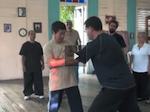Speed is not a function of how fast you can move, but of how quickly you can close distance. As such, speed is not a matter of agility, but of directness.
For example, if I can close the distance between myself and the opponent directly in a linear fashion, I can technically reach the opponent before they reach me. This is because if you can close distance with your whole body, it works as a force multiplier. Not only are you closing distance with one body part (the way an arm would be in a punch), but with multiple body parts. Your lower half is closing distance, your waist is moving closer, AND your arm is reaching out. All these movements together allow for a speed that is quicker than any individual slow or fast twitch muscles on their own. Of course, having quick movements is also of benefit and can work well in conjunction with the rest of the body moving forward.
This works most clearly in a striking context. If I can close distance before they reach me, I’m in a much better position to attack their centre. This should result in also nullifying and disrupting their attack. As their momentum should be lost as soon as their centre is attacked, instinctively retreating or doubling over to guard their centre. This movement to attack the centre is in contrast to blocking an attack. Where blocking their attack requires that force meets force, here we are attacking an unprotected centre to disrupt their attack. Strength is not necessary, only accuracy and directed force especially as it is very very difficult to attack (punch) while simultaneously guarding your middle.
In a push hands context, you can feel (if not always see) the effects of intercepting and disrupting the opponents centre. When the opponents makes a movement (as opposed to a stretch), as long as you have contact with them, it is possible to ‘jam’ their move – rendering it null and void. Although a subtle nuance, it often looks like someone moves forward before getting jerked back to where they were before. In order to jam the opponent, you often have to stretch and ‘block’ their centre from moving. The effectiveness in closing space works best with moving the waist in, making your rotation more powerful when their centre is closest to your centre.
Remembering that taiji has a focus on maintaining a centre while moving, many martial arts do not have the same focus or instruction (although at a high level of any martial art, a centre is often maintained). Just as with any skill, to train this closing of distance, it must be practiced in semi-live sessions. Otherwise our natural reactions of flinching away will take over. We must train to never flinch away. Taiji never retreats.
Video references:
http://practicalmethod.com/2011/08/taiji-applications-2011-online-video-trailer/



{ 4 comments… read them below or add one }
Training to invade and control an opponent’s centre using don’t retreat, don’t move and rotate is core for us, as you say. Push hands is a very important training tool for this reason.
I read this post without reading who wrote it. At some point I thought “That sounds like Brennan”. Donno why 🙂
Good article. Thanks and cheers
Eliminate Fear of Reactivity! Fear of reactivity creates the flinch defense mechanism. Fear of reactivity is only eliminated through proper training .
And trusting your training…